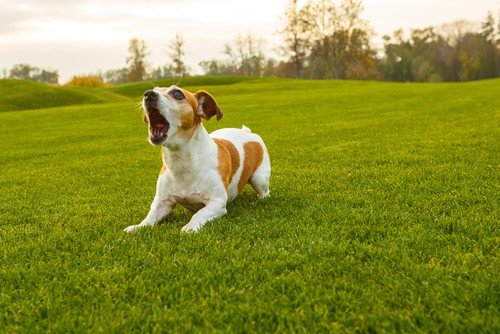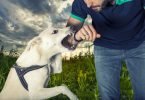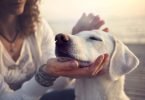You’ve probably seen tons of cute puppy pictures on the internet and wondered, “Hey! I want one!” Or you’ve been planning to adopt a puppy your whole life, and now you’re financially and mentally ready for it. The papers are ready, and you’re taking your puppy to their new home. Soon after, your puppy starts playing with you, but you notice that they seem to be too aggressive. You automatically dismiss this as puppy play. However, what you don’t realize is that it could be a sign of a developing aggressive puppy.
Adopting and taking care of a new puppy is a lot harder than it looks. Moreover, it is harder than adopting an adult dog. You’ll have to teach it everything it needs to know from scratch. This includes things like feeding, potty training, and discipline, the latter being the most important. You would want to raise your puppy without having to fear it because it is too aggressive.
Unfortunately, a lot of people make the mistake of poorly training their puppies while they are young. This then leads them to grow up as aggressive dogs. In this article, we will teach you how to look for signs of aggression within your puppies. We will also give you ideas on how to correct this behavior and ways to deal with an aggressive puppy.
Signs of an Aggressive Puppy
Aggression towards other puppies
You’ve decided to take your puppy to the local dog park for the first time. You are excited about the fact that they will be able to interact and play with other dogs. You might even take a few snaps of your puppy happily playing with them. However, everything took a turn for the worse when your puppy starts snapping, growling, and snaring at other people’s dogs. Your puppy has become so aggressive with other dogs that you had to leave the park earlier and more stressed than expected.
Aggression to humans
Here you are, posting pictures of your new puppy on social media, and now your family and friends want to see it in person. Your friends arrive at your house, and soon after they take a step inside, your puppy starts to bark and growl at your guests. If your puppy starts to growl, snare, or snap at people, especially those who they don’t know or see regularly, you should take measures to correct this behavior as this could pose as a threat to the safety of the people around you, especially children.
Aggressive Behavior During Playtime
Puppies use their mouth to grab onto things, just like how babies would use their hands. Unfortunately, mouths have teeth and puppies could sometimes underestimate their bites, during playtime, which could lead to you getting wounded. If your hands are turning blue or are bleeding from play bites, you have to interrupt this behavior as soon as possible. Let your puppy know that his bites are hurting you. Do not punish the puppy; instead, stop and show dominance over your puppy when he is too aggressive. The following are some tips to help you manage your puppy during playtime:
- Learn when to stop aggressive biting. When your puppy’s bite starts to hurt, stop the play for a while to let him know that his bites are becoming too aggressive. Alternatively, give him proper chew toys to redirect his attention to a different object other than you.
- Give your puppy multiple avenues to play with. Match your dog’s energy level by giving it walks or age-appropriate toys to chew on. If you give your puppy the right amount of play it needs with its energy, they will most likely know the difference when it is playtime or if it is time to relax.
- Put your puppy on a leash when going outside. If you go to a dog park or you just want to go for a walk, your puppy might encounter other dogs or children that might want to play with him. The leash will help you control your puppy when he becomes too rough with the play. Softly tug on the leash if you think your puppy is becoming too aggressive.
- Let your puppy play with other dogs in parks or doggy daycare. Make sure to do this after all vaccinations have been cleared. Let your puppy socialize with other dogs and have it develop the mindset of trust and develop a friendly attitude towards other dogs.
Aggressive Behavior During Feeding Time
Feeding time is essential for every pet. It is also the best time to teach your aggressive puppy a couple of disciplinary actions and observe for signs of severe aggression. Early signs of aggression can be seen as the following during feeding time:
- Your puppy is overly protective of their food bowl.
- They will growl or snap at you if you reach for the bowl, even if it’s empty.
- They growl or snare at you when you walk past by them while they’re eating.
- When you attempt to reach for food that dropped, they start to lunge or snap at you.
- They snatch treats of your hands during training.
Aggressive with Items
Does your puppy bark or snap at you when you come close to a certain item? Do they look overprotective of their favorite toy or their food bowl? Do they often go to a certain place in the house that seems to trigger their aggression? Their instincts to protect something will kick in. Therefore aggression towards any threat is shown, even towards their owners.
Aggressive During Teething
Teething can be a painful process for puppies. They will start to bite and chew onto anything, like furniture or walls, just to alleviate the pain. To counter this, give your puppy an appropriate chew toy. Here are some chew toys that we recommend:
KONG Puppy Toy
Pros
- It is designed to fit in the needs of a growing puppy’s teeth and gums.
- You can put in treats inside the toy.
- Its rubber design is made to withstand power chewing dogs.
Cons
- It could be a choking hazard for some dogs due to its small size.
N-Bone Puppy Teething Ring
Pros
- Helps relieve pain from teething
- Is safe to consume for puppies
- Has calcium for healthy teeth
Cons
- Dogs can break it into smaller chunks which could become choking hazards
Nylabone Just For Puppies Ring Bone
Pros
- Its raised bristles will prevent tartar build-up.
- It has two sizes for both small and big dogs.
Cons
- It is made up of nylon but can easily be taken apart by a strong bite, which could become a choking hazard.
Is My Puppy Showing Dominance?
Conflict aggression, formerly known as dominance, is a type of aggression problem within dogs and is most commonly seen in puppies. This may manifest as guarding toys or food and growling or barking at anything that comes near it. This typically happens when the puppy thinks that its “place” in the family is a threat, causing it to do actions that would put people back in the line. If this happens, do not punish your puppy for asserting dominance. Instead, know the reasons why your dog is showing this type of behavior and work around that cause on how to correct that behavior. Here are some things to take into consideration when your dog is displaying signs of dominance:
Misinterpretation
Behavioral specialists believe that the first time a dog asserts conflict aggression is when there is a disagreement or miscommunication between the owner and the puppy during playtime that gets out of control. This may occur as when a dog feels threatened when you go to near its food bowl or its safe place in the house. A puppy learns to growl and chase away any threat to the item it’s protecting, which further enhances their dominating instinct. When they start to show these signs, stand your ground, and show the puppy that you are not running away from its aggression. Do not reinforce punishment and just wait until they understand that you are the one that is dominant over them.
Hormones
Testosterone is a hormone that makes a dog react more aggressively for longer periods. When your puppy reaches the adolescence stage, it will produce more testosterone. To counter this, have your male dog neutered to lessen the aggression. For female dogs, spaying might make conflict aggression worse, so consult with your veterinarian first before taking any further actions.
Idiopathic Aggression
Idiopathic is a medical term that means the cause is not known or identified. This is commonly seen in dogs that are 1-3 years old. Some behavioral specialists believe that this type of aggression stems from the dog’s instinct of status or poor socializing skills. To prevent this from happening, have your puppy socialize at an earlier stage and expose them to other dogs with full supervision. If the behavior continues, consult with a vet or a professional for further actions.
Triggers
There are a few common things that could trigger conflict aggression within your puppy. Here is a list of the most common ones:
- Picking up your dog could result in biting or growling if your dog is not used to getting picked up when he was still younger.
- Reaching over or picking up things that they own like food bowls or their favorite toys can trigger conflict aggression, as they might think that you are separating their thing from them.
Item or furniture guarding. Dogs may start to become attached to certain furniture. They may assert dominance to members of the household that they feel like they are under them.
Knowing the Difference between Play from Aggressive Behaviors
The following tips will help you identify if your puppy is playful or aggressive towards you:
Is your puppy wagging his tail and bowing his head?
If your dog bows and is wagging their tail, this is a good indication that they are just playful. Dogs will do these things when they feel comfortable and happy with their environment.
Does your puppy reciprocate your actions?
Monitor your puppy’s behavior by testing if it responds well to you. There are a few ways to check this, first, stop playing with them and see if they also halt immediately. Second, try clapping loudly and see if your puppy reacts to you. Third, see if your puppy takes turns when roughhousing. If your puppy responds to your actions, this means that it is attentive to you and just wants to play around.
Does your puppy show signs of fear or pain?
If your dog is scared of something or is in pain, it will most likely become aggressive to protect itself from any harm. Look for signs like their ears pinned back. Their eyes are darting. The tail is tucked between their legs, or it is leaning its whole body towards the floor. If these are present, you’ll have to know what’s causing them fear or pain. You may need to consult a specialist if you are unsure about the cause.
Is your puppy teething?
Teething puppies will experience pain, and for them to alleviate that, they will chew on anything they find, including furniture or your hands. Give them appropriate chew toys for them to use.
What Can You Do to Fix Puppy Aggression?
Aggressive dogs come to be because of poor training from their puppy days. To prevent this from happening, here are some tips that you can do to raise your dog properly.
Professional Puppy Training
There are plenty of professional dog trainers that will help you train your dog properly. However, you should properly choose an agency where their training methods are on par with what you would like your dog to experience. Asks friends or join groups to discuss which dog trainers are the best in giving safe yet disciplined training for your dogs. Make sure that the institution you choose is complete with their training certificates and permits. Do not be fooled by cheap agencies that promise to train your dogs at a lower price as they could be instilling discipline through punishment towards your dog.
Puppy Training Videos
If you don’t have the budget for a professional dog trainer, you can look up puppy training videos on the internet. There are plenty of puppy training videos on YouTube or on Facebook that is run by professionals. Be patient and do not rush the process if your puppy does not cooperate at first.
Here are some puppy training videos that we recommend for you to watch:
- How to Stop Puppy Biting and Chewing by Cesar Millan
- How to Train Your Puppy to Stop Biting by Zak George’s Dog Training Revolution
- Basic Obedience Training | Cesar 911 by Nat Geo WILD
Reward-based Training
Studies have shown that punishment-based methods of training have been proven to worsen aggression within your dog. 80% of dogs presented to behavioral specialists for aggression have been trained by their owners or so-called “dog trainers” using punishment methods. If you train your dog using rewards or treats, this will facilitate a more engaging environment for your dog. They will most likely participate during training if presented with a reward. The less stress the dog is during training, the easier they will pick up on the actions you want them to learn. Also, do not focus on your dog when they do something bad. Instead, focus more on when they do something you like and reward them with belly rubs or give them their favorite treats appropriately.
Ask Help from an Experienced Dog Owner
There is nothing wrong with asking help from someone who is experienced at raising dogs. For first-time dog owners or puppy owners, raising a dog could spell out the worst for everyone if done incorrectly. You can join groups, forums, or clubs on the internet or in your local community where you can gain tips on how to raise your dog from experienced dog owners. Opt also to ask reputable dog breeders on how to raise your puppies according to their age properly. You might also want to visit and volunteer at dog shelters before you adopt, just to have a feel of how to take care of dogs and puppies.
Consult a Veterinarian
If your puppy continues to be aggressive even after all proper training has been done, it is time to consult a veterinarian. Your puppy might have an underlying health issue that may be causing him pain, which in turn manifests as aggression.
Conclusion
Puppies are great to have around, not only as pets but as a part of the family. Raising one could be challenging, especially if it’s your first time handling one. We recommend adopting older dogs if you’re a first-time dog owner or have someone with you that knows how to handle properly and raise puppies.
There are no bad dogs, just bad owners. Dogs would not grow up to become aggressive if they were properly trained when they were younger. Do not give up on your puppy when they turn out to become aggressive and not the way you want them to be. Ask help from experienced dog owners or professionals with raising your dog. When raised properly, your puppy will become an amazing companion for you.






